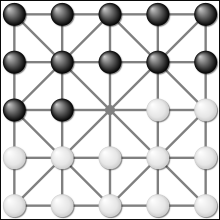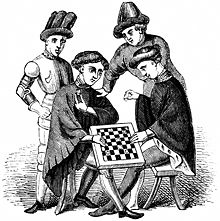Ancient games
Similar games have been played for millennia.[2] A board resembling a checkers board was found in Ur dating from 3000 BC.[4] In the British Museum are specimens of ancient Egyptian checkerboards, found with their pieces in burial chambers, and the game was played by the pharaoh Hatshepsut.[2][5] Plato mentioned a game, πεττεία or petteia, as being of Egyptian origin,[5] and Homer also mentions it.[5] The method of capture was placing two pieces on either side of the opponent’s piece. It was said to have been played during the Trojan War.[6][7] The Romans played a derivation of petteia called latrunculi, or the game of the Little Soldiers. The pieces, and sporadically the game itself, were called calculi (pebbles).[5][8] Like the pawn in Chess, Alquerque was probably derived from πεττεία and latrunculi by removing the necessity for two pieces to cooperate to capture one, although, like Ghanaian draughts, the game could still be declared lost by a player with only one piece left.
Alquerque

An Arabic game called Quirkat or al-qirq, with similar play to modern checkers, was played on a 5×5 board. It is mentioned in the tenth-century work Kitab al-Aghani.[4] Al qirq was also the name for the game that is now called nine men’s morris.[9] Al qirq was brought to Spain by the Moors,[10] where it became known as Alquerque, the Spanish derivation of the Arabic name. It was maybe adapted into a derivation of latrunculi, or the game of the Little Soldiers, with a leaping capture, which, like modern Argentine, German, Greek and Thai draughts, had flying kings which had to stop on the next square after the captured piece, but pieces could only make up to three captures at once, or seven if all directions were legal. That said, even if playing al qirq inside the cells of a square grid was not already known to the Moors who brought it, which it probably was, either via playing on a chessboard (in about 1100, probably in the south of France, this was done once again using backgammon pieces,[11] thereby each piece was called a «fers», the same name as the chess queen, as the move of the two pieces was the same at the time)[12] or adapting Seega using jumping capture. The rules are given in the 13th-century book Libro de los juegos.[4]
Crowning

The rule of crowning was used by the 13th century, as it is mentioned in the Philippe Mouskés‘s Chronique in 1243[4] when the game was known as Fierges, the name used for the chess queen (derived from the Persian ferz, meaning royal counsellor or vizier). The pieces became known as «dames» when that name was also adopted for the chess queen.[12] The rule forcing players to take whenever possible was introduced in France in around 1535, at which point the game became known as Jeu forcé, identical to modern American checkers.[4][13] The game without forced capture became known as Le jeu plaisant de dames, the precursor of international checkers.
